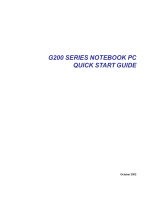
2
This manual and any examples contained herein are provided “as is” and are subject to
change without notice. Quanta Computer Inc. makes no warranty of any kind with regard to
this manual, including, but not limited to, the implied warranties of merchantability and fitness
for a particular purpose. Quanta Computer Inc. shall not be liable for any errors or for
incidental or consequential damages in connection with the furnishing, performance, or use
of this manual or the examples herein.
Consumer transactions in Australia and the United Kingdom: The above disclaimers and
limitations shall not apply to Consumer transactions in Australia and the United Kingdom
and shall not affect the statutory rights of Consumers.
© Copyright Quanta Computer Inc. 2002. All rights reserved. Reproduction, adaptation, or
translation of this manual is prohibited without prior written permission of Quanta Computer
Inc., except as allowed under the copyright laws.
The programs that control this product are copyrighted and all rights are reserved. Repro-
duction, adaptation, or translation of those programs without prior written permission of
Quanta Computer Inc. is also prohibited. Portions of the programs that control this product
may also be copyrighted by Microsoft Corporation, Phoenix Technologies, Ltd., ATI
Technologies Inc., S3 Graphics Incorporated, Intel Corporation, and Adobe Systems
Incorporated. See the individual programs for additional copyright notices.
This product incorporates copyright protection technology that is protected by method
claims of certain U.S. patents and other intellectual property rights owned by Macrovision
Corporation and other rights owners. Use of this copyright protection technology must be
authorized by Macrovision Corporation and is intended for home and other limited viewing
uses only unless otherwise authorized by Macrovision Corporation. Reverse engineering or
disassembly is prohibited.
Microsoft©, MS-DOS©, and Windows© are U.S. registered trademarks of Microsoft
Corporation. Pentium and the Intel Inside logo are U.S. registered trademarks and
Celeron™ and SpeedStep™ are U.S. trademarks of Intel Corporation. Adobe© and Acro-
bat© are trademarks of Adobe Systems Incorporated.
NOTICE




















